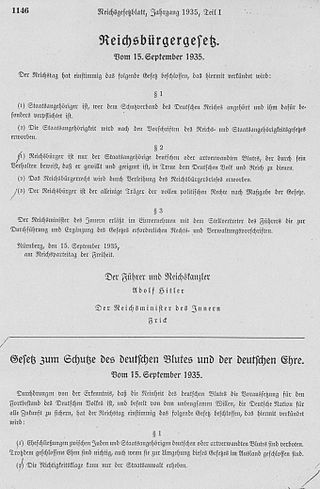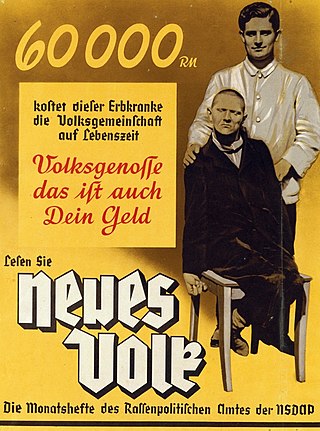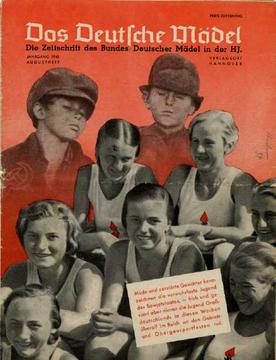
Nazi Germany, officially known as the German Reich until 1943, later the Greater German Reich, was the German state between 1933 and 1945, when Adolf Hitler and the Nazi Party controlled the country, transforming it into a totalitarian dictatorship. The Third Reich, meaning "Third Realm" or "Third Empire", referred to the Nazi claim that Nazi Germany was the successor to the earlier Holy Roman Empire (800–1806) and German Empire (1871–1918). The Third Reich, which the Nazis referred to as the Thousand-Year Reich, ended in May 1945, after only 12 years, when the Allies defeated Germany and entered the capital, Berlin, ending World War II in Europe.

Nasjonal Samling was a Norwegian far-right political party active from 1933 to 1945. It was the only legal party of Norway from 1942 to 1945. It was founded by former minister of defence Vidkun Quisling and a group of supporters such as Johan Bernhard Hjort – who led the party's paramilitary wing (Hirden) for a short time before leaving the party in 1937 after various internal conflicts. The party celebrated its founding on 17 May, Norway's national holiday, but was founded on 13 May 1933. Nasjonal Samling was made illegal and disbanded at the end of World War II, on 8 May 1945.

The League of German Girls or the Band of German Maidens was the girls' wing of the Nazi Party youth movement, the Hitler Youth. It was the only legal female youth organization in Nazi Germany.

Gertrud Emma Scholtz-Klink, néeTreusch, later known as Maria Stuckebrock, was a Nazi Party member and leader of the National Socialist Women's League (NS-Frauenschaft) in Nazi Germany.
Volksgemeinschaft is a German expression meaning "people's community", "folk community", "national community", or "racial community", depending on the translation of its component term Volk. This expression originally became popular during World War I as Germans rallied in support of the war, and many experienced "relief that at one fell swoop all social and political divisions could be solved in the great national equation". The idea of a Volksgemeinschaft was rooted in the notion of uniting people across class divides to achieve a national purpose, and the hope that national unity would "obliterate all conflicts - between employers and employees, town and countryside, producers and consumers, industry and craft".

Blood and Soil is a nationalist slogan expressing Nazi Germany's ideal of a racially defined national body ("Blood") united with a settlement area ("Soil"). By it, rural and farm life forms are idealized as a counterweight to urban ones. It is tied to the contemporaneous German concept of Lebensraum, the belief that the German people were to expand into Eastern Europe, conquering and displacing the native Slavic and Baltic population via Generalplan Ost.

Rassenschande or Blutschande was an anti-miscegenation concept in Nazi German racial policy, pertaining to sexual relations between Aryans and non-Aryans. It was put into practice by policies like the Aryan certificate requirement, and later by anti-miscegenation laws such as the Nuremberg Laws, adopted unanimously by the Reichstag on 15 September 1935. Initially, these laws referred predominantly to relations between ethnic Germans and non-Aryans, regardless of citizenship. In the early stages the culprits were targeted informally; later, they were punished systematically and legally.

The propaganda used by the German Nazi Party in the years leading up to and during Adolf Hitler's dictatorship of Germany from 1933 to 1945 was a crucial instrument for acquiring and maintaining power, and for the implementation of Nazi policies.

The National Socialist Women's League was the women's wing of the Nazi Party. It was founded in October 1931 as a fusion of several nationalist and Nazi women's associations, such as the German Women's Order which had been founded in 1926. From then on, women were subordinate to the NSDAP Reich leadership. Guida Diehl was its first speaker (Kulturreferentin).
Leila J. Rupp is a historian, feminist, and professor of Feminist Studies at the University of California, Santa Barbara. She is an alumna of Bryn Mawr College, a member of the Seven Sisters women's colleges, where she received her bachelor's degree in 1972 as well as Ph.D. in 1976, both in history. Her areas of interest include women's movements, sexuality, and LGBT and women's history.

During American involvement in World War II (1941–45), propaganda was used to increase support for the war and commitment to an Allied victory. Using a vast array of media, propagandists instigated hatred for the enemy and support for America's allies, urged greater public effort for war production and victory gardens, persuaded people to save some of their material so that more material could be used for the war effort, and sold war bonds.

Ostarbeiter was a Nazi German designation for foreign slave workers gathered from occupied Central and Eastern Europe to perform forced labor in Germany during World War II. The Germans started deporting civilians at the beginning of the war and began doing so at unprecedented levels following Operation Barbarossa in 1941. They apprehended Ostarbeiter from the newly-formed German districts of Reichskommissariat Ukraine, District of Galicia, and Reichskommissariat Ostland. These areas comprised German-occupied Poland and the conquered territories of the Soviet Union. According to Pavel Polian, although the Ostarbeiter from most occupied territories were predominantly men, of the "eastern workers" taken from occupied Soviet territories over 50% were women, and of those from Poland nearly 30% were women. Eastern workers included ethnic Ukrainians, Poles, Belarusians, Russians, Armenians, Tatars, and others. Estimates of the number of Ostarbeiter range between 3 million and 5.5 million.

Neues Volk was the monthly publication of the Office of Racial Policy in Nazi Germany. Founded by Walter Gross in 1933, it was a mass-market, illustrated magazine. It aimed at a wide audience, achieving a circulation of 300,000. It appeared in physicians' waiting rooms, libraries, and schools, as well as in private homes.

Das Deutsche Mädel was the Nazi propaganda magazine aimed at girls, particularly members of League of German Girls. In fact, it was the official organ of the League. The magazine was published on a monthly basis between 1933 and 1942.

The propaganda of the Nazi regime that governed Germany from 1933 to 1945 promoted Nazi ideology by demonizing the enemies of the Nazi Party, notably Jews and communists, but also capitalists and intellectuals. It promoted the values asserted by the Nazis, including heroic death, Führerprinzip, Volksgemeinschaft, Blut und Boden and pride in the Germanic Herrenvolk. Propaganda was also used to maintain the cult of personality around Nazi leader Adolf Hitler, and to promote campaigns for eugenics and the annexation of German-speaking areas. After the outbreak of World War II, Nazi propaganda vilified Germany's enemies, notably the United Kingdom, the Soviet Union and the United States, and in 1943 exhorted the population to total war.

Women in Nazi Germany were subject to doctrines of Nazism by the Nazi Party (NSDAP), which promoted exclusion of women from the political and academic life of Germany as well as its executive body and executive committees. On the other hand, whether through sheer numbers, lack of local organization, or both, many German women did indeed become Nazi Party members. In spite of this, the Nazi regime officially encouraged and pressured women to fill the roles of mother and wife only. Women were excluded from all other positions of responsibility, including political and academic spheres.
The Reich Bride Schools were institutions established in Nazi Germany in the late 1930s. They were created to train young women to be "perfect Nazi brides", indoctrinated in Nazi ideology and educated in housekeeping skills. The fiancées of prominent SS members and senior Nazi Party officials were taught skills including cooking, child care, ironing and to how to polish their husbands' uniforms and daggers. They were required to swear oaths of loyalty to Adolf Hitler, to pledge to raise their children as Nazis and to marry in what the Nazis alleged to be ceremonies based on pre-Christian model—ceremonies that Nazi officials presided over, rather than ceremonies in churches.
Leila Negra, the stage name of Marie Nejar, is an Afro-German singer and actress. She began her career as a child film actor in the 1940s, became a singer after World War II, and left performing in the late 1950s to become a nurse.
Nippon Fujin was a Japanese political magazine targeting women. The magazine was one of the best-selling magazines during World War II in Japan. It existed between 1942 and 1945.

In Nazi Germany, lesbians who were sent to concentration camps were often categorized as "asocial", if they had not been otherwise targeted based on their ethnicity or political stances. Female homosexuality was criminalized in Austria, but not other parts of Nazi Germany. Because of the relative lack of interest of the Nazi state in female homosexuality compared to male homosexuality, there are fewer sources to document the situations of lesbians in Nazi Germany.













